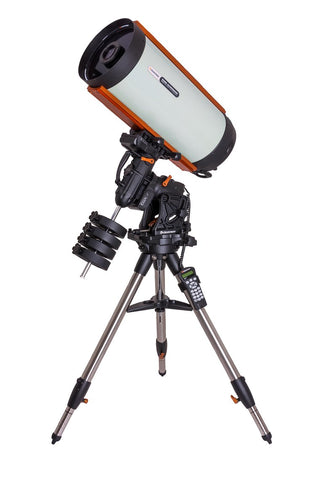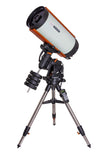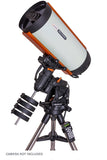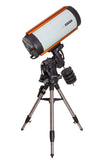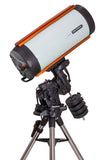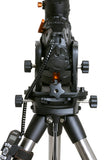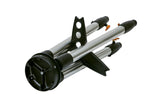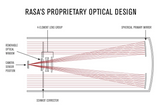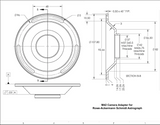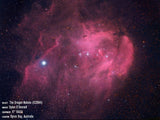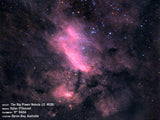- 11” f/2.2 Rowe-Ackermann Schmidt Astrograph (RASA) V2 uses rare-earth glass for images free of false color, coma, and field curvature
- Heavy duty CGX computerized equatorial mount with 55-lb payload capacity
Description
Optical Performance
The RASA 11 V2 features optics with 4-element rare-earth glass for images free of false color and aberrations like coma and field curvature. The optical quality and spot size across the entire image circle are unprecedented for an astrograph in this price range—or even that of a much more expensive instrument. The design also provides minimal vignetting.
Advanced Features
RASA 11 V2 utilizes the new Ultra-Stable Focus System (USFS). At the heart of this system is a precision linear ball bearing. The bearing serves to minimize focus shift (unwanted lateral motion of the primary mirror during focusing which causes shifting of the image) and mirror flop (movement of the primary mirror when the telescope is pointing to different positions in the sky). The USFS is also compatible with the optional Celestron Focus Motor (#94155-A). The integrated 12V DC MagLev fan reduces cooldown time and provides optimal airflow through the dust filtered optical tube.
Engineered as a complete astroimaging system, every component of the RASA 11 V2 is optimized for peak performance with DSLR and astronomical CCD cameras. Down to the thickness of the glass used in the included fully-multicoated optical window or optional imaging filter, every component of the system has been taken into careful consideration to work together seamlessly. The Dovetail CGE bars on the top of the optical tube provides a connection for use of optional accessories like a guidescope.
CGX Mount
Celestron’s workhorse CGEM mount lineup has been the German Equatorial backbone for telescopes ranging from 6 to 11 inches of aperture. Since that time, many more astro-imagers and planetarium controlled setups have emerged as backyard telescope technology has evolved. Celestron’s engineering team applied their years of experience designing German Equatorial mounts to the all-new CGX EQ, a culmination of all the advancements made to our technologies, value, and ease-of-use.
The new CGX was designed to better support your telescope for both visual and astro-imaging pursuits. Key design goals included a lower profile EQ head, which provides a more compact and therefore more stable setup; a better drive system; remote operation-friendly with home and limit optical sensors; easier polar alignment adjustments; and better cable management. In addition to that, we’ve made mechanical and ergonomic improvements throughout to make the mount sturdier, easier to use, and transport. The CGX is our new Equatorial backbone to support a wide range of telescopes.
Specifications
| OPTICAL TUBE INFO: | |
|---|---|
| Optical Design | Rowe-Ackermann Schmidt Astrograph |
| Aperture | 279mm (11") |
| Focal Length | 620mm (24.4") |
| Focal Ratio | f/2.2 |
| Central obstruction diameter | 114mm (4.48") (41% of aperture diameter) |
| Light Gathering Power (Compared to human eye) | 1588x |
| Resolution (Rayleigh) | 0.49 arc seconds |
| Resolution (Dawes) | 0.41 arc seconds |
| Image Circle | 43.3mm (1.7") Ø , 4.0° |
| Useable field | 52mm (2.04") Ø , 4.8° only minimal performance loss at edge of FOV |
| Wavelength range | 400 - 700 nm |
| Spot size | < 4.4 μm RMS across FOV |
| Optical Coatings | StarBright XLT |
| Off-axis Illumination | 83% at 21mm (.82") off-axis |
| Optical Window | 68mm (2.67") Ø |
| Back focus with included camera adapter | 55mm (2.16") |
| Back focus from top of threaded collar | 72.8mm (2.86") |
| Optical Tube | Aluminum |
| Optical Tube Length | 838.2mm (33") |
| Optical Tube Diameter | 330.2mm (13") |
| Focuser | Ultra-Stable Focus System |
| Finderscope | Not included |
| Optical Tube Weight | 43 lbs (19.5 kg) |
| Other Features | Ventilation fan, dual dovetail mounting bars |
| Included items | 42mm (1.65") T-thread camera adapter | 48mm (1.89") camera adapter | Dust cover | Fan battery pack |
| Dovetail | CGE Dovetail Bar |
| MOUNT INFO: | |
| Mount Type | Computerized Equatorial |
| Instrument load capacity | 55 lbs (25 kg) |
| Height adjustment range (includes mount and tripod) | 1200.15mm - 1968.5mm (47.25" - 77.5") |
| Tripod Leg Diameter | 50.8mm (2") Steel tripod |
| Latitude adjustment range | 3° - 65° |
| Mount Head Weight | 44 lbs (20 kg) |
| Accessory Tray | Yes |
| Tripod Weight | 19.2 lbs (8.7 kg) |
| Weight of Counterweights | 4 x 11 lbs |
| Slew Speeds | 9 slew speeds - max speed 4°/second |
| Tracking Rates | Sidereal, Solar and Lunar |
| Tracking Modes | EQ North & EQ South |
| GPS | N/A |
| Dovetail Compatibility | Dual saddle plates (CG-5 and CGE saddle) |
| Number of Auxiliary ports | 2 Aux ports (Hand Control can use either Aux port) |
| Autoguide port | Yes |
| USB Port | Yes, input for Mount and Hand Control |
| Power Requirements | 12V DC, 4 amps |
| Motor Drive | DC servo motors |
| Alignment Procedures | 2-Star Align, 1-Star Align, Solar System Align, Last Alignment, Quick Align |
| Periodic Error Correction | Yes |
| Computer Hand Control | 2 line x 18 character backlit Liquid Crystal Display, 19 LED backlit buttons, USB 2.0 port for PC connection |
| NexStar+ Database | 40,000+ objects, 100 user defined programmable objects. Enhanced information on over 200 objects |
| Software | CPWI Telescope Control Software, Celestron Starry Night Special Edition Software, SkyPortal App |
| Total Kit Weight | 150.2 lbs (68 kg) |
| Included Items | CGX Equatorial Head | CGX Tripod | Accessory Tray | 4 x 11 lbs counterweights | NexStar+ Hand Control | Counterweight Shaft | 8mm Allen Wrench | 12V DC Power Cable | Hand Control Holster |

